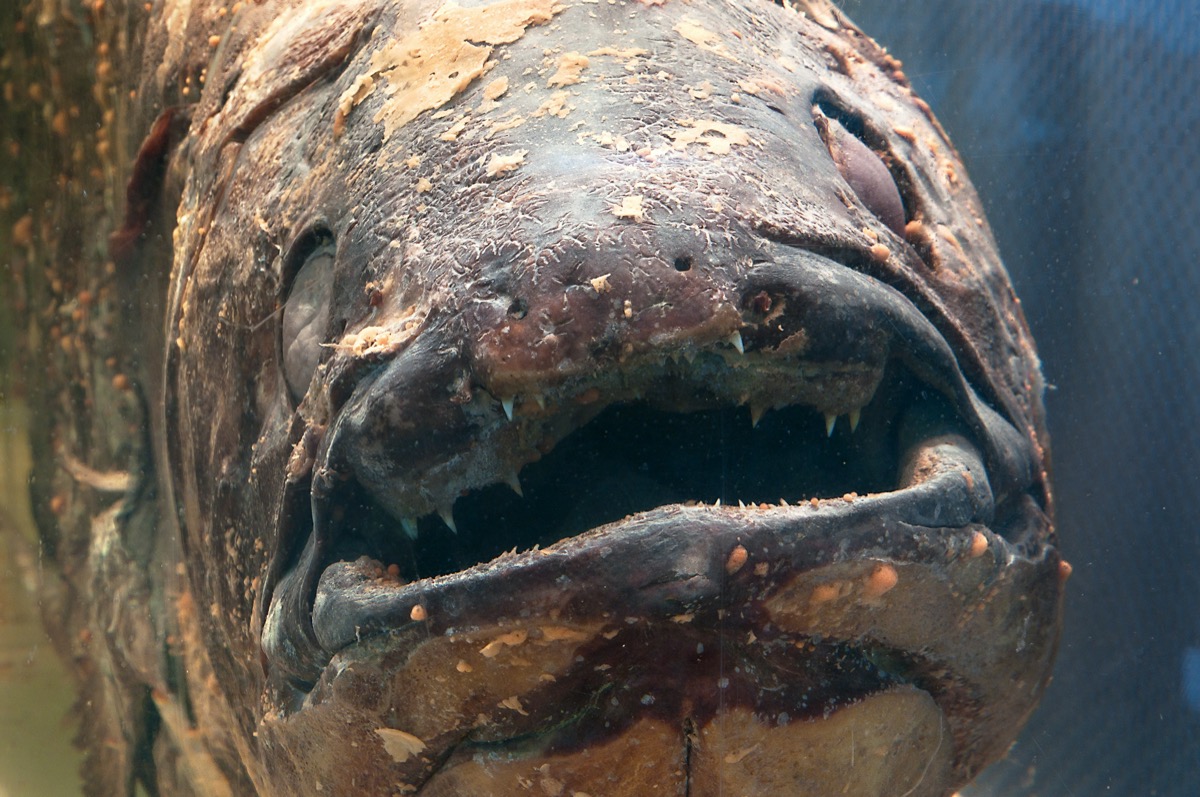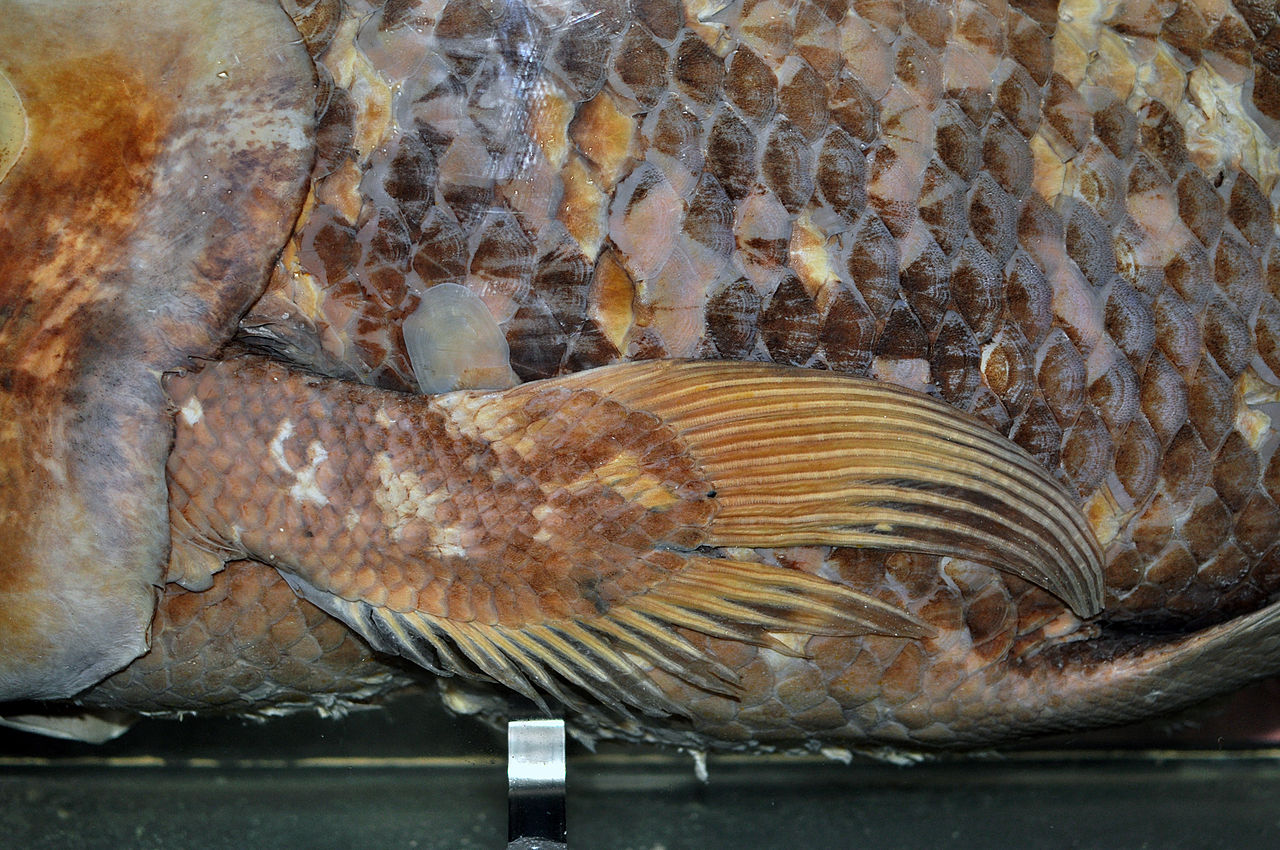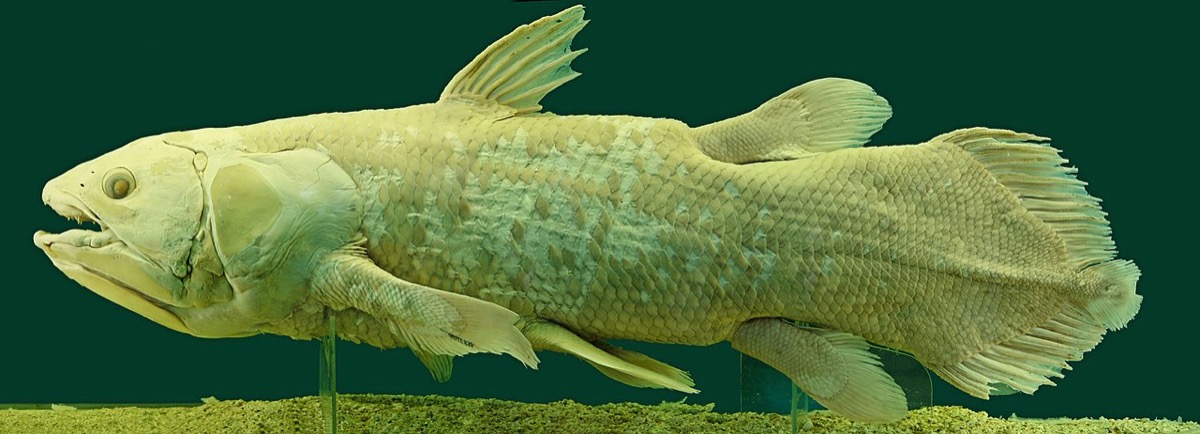Charismatic Creature Corner: Chonky Fish Edition
12:36 minutes

In South Africa in 1938, a young museum curator named Marjorie Courtenay-Latimer was performing one of her regular duties when she saw something incredible. Courtenay-Latimer was tasked with inspecting fish brought in by local fishermen that were considered out of place in the region. That’s how she found what she later called the most beautiful fish she had ever seen: a coelacanth, thought to be long extinct.
Courtenay-Latimer’s discovery did not immediately register as a coelacanth, because the creature was thought to have gone extinct at the end of the Cretaceous period, 66 millions years ago. The fish was seen as a modern Lazarus—a mysterious creature brought back from the dead, stumping scientists.

At six feet long and 200 pounds, some consider the coelacanth to be a big, beautiful fish. According to Prosanta Chakrabarty, professor and curator of fishes at Louisiana State University, the coelacanth is the meathead of the sea.
“They are chunky,” Chakrabarty said. “You can hold their fin and it feels like you’re shaking somebody’s hand.”
Because they’re so old, coelacanths are closer to the human genealogical lineage than they are to any modern fish. But because this is the Charismatic Creature Corner, only one thing really matters: Is it charismatic enough to enter the Charismatic Creature Corner Hall of Fame?
Joining guest-host John Dankosky to argue for the coelacanth entering the Charismatic Creature Corner Hall of Fame is SciFri producer Kathleen Davis and Chakrabarty.

Invest in quality science journalism by making a donation to Science Friday.
Dr. Prosanta Chakrabarty is the author of Explaining Life Through Evolution, and Curator of Fishes at Louisiana State University in Baton Rouge, Louisiana.
JOHN DANKOSKY: It’s the end of another week, so let’s have some fun before we end for today. It’s time for another Charismatic Creature Corner.
[MUSIC PLAYING]
[ANIMAL SOUNDS]
Joining me today per usual is our Charismatic Creature Correspondent, Sci-Fri producer Kathleen Davis. Hey Kathleen.
KATHLEEN DAVIS: Hello, hello.
JOHN DANKOSKY: what creature have you brought us this week?
KATHLEEN DAVIS: Well, to remind our listeners, this is the segment where I bring you a creature that is let’s say less than obviously cute and charming, and so an expert and I will try to convince you that this creature has got the chops to enter our Charismatic Creature Corner Hall of Fame.
JOHN DANKOSKY: OK. OK, let’s do it.
KATHLEEN DAVIS: And this creature, if you deem them charismatic, will sit among slime molds, vampire bats, and hell ants in this prestigious position.
JOHN DANKOSKY: It is quite the Hall of Fame you’ve put together. So what do you have for us this week?
KATHLEEN DAVIS: Yes. So I wanted to do something a little bit different. In the past we have talked about some creatures that are alive today in 2021, and we’ve also talked about some that are extinct. But the creature that I have brought for you today was actually thought to be extinct for millions of years before it was actually rediscovered back in the 1930s. Do you have any guesses for what this is?
JOHN DANKOSKY: Let me see. I mean, I don’t know. Maybe some sort of bird, dinosaur hybrid of some sort?
KATHLEEN DAVIS: OK, you’re about halfway there, maybe you can say. It is actually coelacath which is a big old fish that is sometimes called a living fossil.
JOHN DANKOSKY: A coelacanth. Could you spell that for me?
KATHLEEN DAVIS: Yes. It is a word that I have misspelled probably three dozen times as I have prepared for this. OK, are you ready it is C-O-E-L-A-C-A-N-T-H
JOHN DANKOSKY: OK, so exactly like it sounds.
KATHLEEN DAVIS: Yeah, right. Now, I am no expert on coelacanths, so I am going to actually turn it over to someone who is. They are a mega coelacanth fan. Dr. Prosanta Chakrabarty is a professor and curator of fishes at Louisiana State University in Baton Rouge, Louisiana. Welcome to Science Friday.
PROSANTA CHAKRABARTY: Thanks for having me.
KATHLEEN DAVIS: John, do you want to start off the line of charismatic questioning?
JOHN DANKOSKY: Oh, sure. Well, let’s see. The first thing I’m going to have to know, to determine whether or not this is a Charismatic Creature is, what exactly does a coelacanth look like?
PROSANTA CHAKRABARTY: A coelacanth is let’s say the football player looking thing of a fish. So when it was rediscovered by Marjorie Courtney Latimer, she said it was the most beautiful fish she ever saw. So these things are humongous, so six feet, 200 pound thing, with blue colored scales, big bright things, with whitish flecks. So they’re really gorgeous.
KATHLEEN DAVIS: Now I’m looking at a picture of a ceolacanth, and our listeners can see them too on our website, sciencefriday.com/bigfish. We figured that coelacanth was too hard to spell, so we had to get creative. But looking at this fish, I mean, it really does look like it belongs in dinosaur times. It’s pretty meaty looking, I would say.
PROSANTA CHAKRABARTY: They’re chunky. If you hold on there, the cool thing is that their fins have limb bones similar to our limb bones. So our arms and legs. And so you can hold their fin, and it feels like you’re shaking somebody’s hand. It’s really incredible. But they’re– they’re kind of chunky.
JOHN DANKOSKY: So, they’re big, they’re kind of chunky, but I don’t know. These limb bones sound kind of cool. What else makes these fish cool aside from how old they are?
PROSANTA CHAKRABARTY: Well, yeah besides how old they are. I mean they’re rediscovery sort of made us better understand just how closely related they are to us, and in fact they’re part of the same part of the tree of life as us. So they’re lobed finned fishes, which we are also lobed finned fishes. The sarcopterygii. And almost every other fish you can think of is a ray finned fish. So a coelacanth is actually more closely related to you or to a sparrow than it is to almost any other fish you can think of. Like a goldfish or a catfish.
So for me that alone, I mean that that’s pretty charismatic. If a fish that’s more closely related to you than to other fishes.
KATHLEEN DAVIS: Now I have to ask you about something that I came across in my research. That coelacanths have a butt fin? I have seen it described. A, is this true, and B, what the heck is a butt fin?
PROSANTA CHAKRABARTY: It’s so funny. I love that you asked me that, because yeah, everybody concentrates on their pectoral fins, which are like their arms and their pelvic fins which are like their legs. But they have a bony second dorsal fin, so it’s like a back hand and an anal fin that’s also full of bones, kind of like a butt leg. So I could use a backhand.
KATHLEEN DAVIS: It would make a probably better at a sport.
PROSANTA CHAKRABARTY: Yeah. Or scratching your back.
KATHLEEN DAVIS: Yeah, right.
JOHN DANKOSKY: So you’re making a pretty convincing case that this is not really like modern fish. Right? This is something that has quite a few differences from say, I don’t know, a trout or a bass.
PROSANTA CHAKRABARTY: Well, so trouts and basses are in this other part of the tree of life, that are the ray fin fishes. And these guys, they have a mix of old and new characters, which I think makes them charismatic. So they have things that were around for 400 million years, and then they have these other organs that no one else has. They have this rostral organ which is not dissimilar to what sharks have, which it gives them an electromagnetic sense. So they can sense their prey. And really no other fishes have that.
Most fishes have like a gas bladder that’s full of air. Instead they fill theirs with fatty oils and lipids so they can float. And so other fishes don’t do that.
And no other fish, I would dare you to find another fish that swims in a doggy paddle. And it’s so cute, and they’re so dumb, too. Have this big brain case, and that’s full of fat too. I mean they’re just bodies just full of fat and oils. And even their brain is mostly fat and oil, so they’re not intellectual giants. But they’re awesome.
JOHN DANKOSKY: Hold it, but if they’re filled with fat and oil, I mean should we be eating them? I don’t know, do they taste good? Would they be good for us?
PROSANTA CHAKRABARTY: They taste terrible. I have not personally eaten one, but their skin, like also like sharks, is quite full of urea. So they have another organ that helps them do that, or actually doesn’t do it as well or as efficiently as some other animals. So they don’t taste good. Yeah, you would think, yeah, oily. Yummy. But no it’s the bad kind of oil.
JOHN DANKOSKY: I’m John Dankosky, and this is Science Friday from WNYC Studios. And we’re here in Charismatic Creature Corner learning about the coelacanth. I vaguely remember about the rediscovery of this fish. Were there like fossilized coelacanths in museums before it was refound?
PROSANTA CHAKRABARTY: Yeah. In fact they were first described from hundreds of million year old fossils that were actually small, a few inches long, and in fresh water. And so out pops this gigantic, like I said six foot, 200 pound fish off the East coast of Africa. And there’s now two species known. Another one from Indonesia, which also has sort of a dubious discovery process. But yeah, this 20-year-old South African curator, Marjorie Courtney Latimer, who is very curious about stuff and not knowledgeable about fishes, but she found this fish, and knew it was something special.
And back in 1938. And the last time that coelacanths had been known were from fossils from 80 million years ago. So their fossil record went from 360 or so million years ago to 80 million years ago. And then boom, rediscovered in 1938.
KATHLEEN DAVIS: Now I’m wondering, and you mentioned that they taste terrible. But I’m wondering what may have helped them live through so many millions of years. I mean, are there theories for why they’ve lasted this long?
PROSANTA CHAKRABARTY: Yeah. Well, they’re pretty shy, it seems. So they hide out in these deep sea caves. So they live between 2,000 feet and 300 feet or so, and they find these sort of extinct volcanic caves, and they just hang out in there during the daytime or whenever there may be a shark around, their only real predators. And they stay in little groups. So they’re not coming out up to the surface where anyone would see them.
So they’re quite uncommon. Even just a couple of them may be collected every so often, incidentally, just from trying to catch something else. So they probably evaded detection for a long time just because they live in such deep water and stay down there, and not a lot of fish hooks go into caves. So it’s when they come out of those caves to hunt themselves that they’re a little bit more vulnerable.
JOHN DANKOSKY: If they live in caves, how’s their eyesight?
PROSANTA CHAKRABARTY: They have big eyes, but they don’t– it’s not like they’re blind. They are attuned to these blue wavelengths that like they’re the color of their scales, and for deep sea life so they can see bioluminescent creatures. But yeah, they don’t have particularly awesome or terrible vision.
KATHLEEN DAVIS: Now, I’m about to show my youth here for a minute. But the first time that I came across the coelacanth was actually in the game Animal Crossing. And one of the things that you can do in that game is fish. And the coelacanth is notoriously one of the hardest fish to find in that game. I mean, do people fish them and are they hard to catch?
PROSANTA CHAKRABARTY: So people don’t fish them intentionally. But they do come up every once in a while when people are fishing for other deep sea fishes. And unfortunately we don’t know what their population sizes are. They’re pretty likely that their population sizes are pretty low. So when they do come up, it’s something to be concerned about, because they’re even catching two or three of these every few months or every year or so, we don’t know what that does to their populations.
So they live maybe 60 years, so that might be a long time. They can have 20 or so pups, they give birth to live babies, live pups. And we don’t– those are very poorly known. Like how their life history works in the deep sea. So we don’t want to find out about them from fishermen catching them. We want to know more about them in situ, in these deep sea caves. And unfortunately we still don’t know that much about them.
KATHLEEN DAVIS: Well, I am convinced that this is a Charismatic Creature, but I’m not the one who matters in this situation. Because we are just about out of time, I have to ask you, John, do you think that the coelacanths belong in the Charismatic Creature Corner Hall of Fame?
JOHN DANKOSKY: I got to tell you, I was not encouraged when I first heard about this. It just seems like a big fish to me, right? It just seems like a big, meaty fish. I think it was the thing that you said about how closely we’re related to them compared to modern fish. I think that’s the thing that really makes me feel, yeah, this is actually a pretty Charismatic Creature.
KATHLEEN DAVIS: So just because it’s like you. That’s why.
JOHN DANKOSKY: Just, well, that’s it is, the more it is like me, the more charismatic I think it is. You’re on to me, Kathleen.
KATHLEEN DAVIS: Prosanta, I don’t think I need to ask you this question, but do you think that coelacanths are charismatic?
PROSANTA CHAKRABARTY: I think they’re the absolute best. You can– I’m even wearing a coelacanths shirt, and my cup has a coelacanths sticker. I love them. I just think they’re the coolest animals on the planet. So if just being close to as charismatic as John, then I’ll take it. They’re as close to the John as any animals you guys will talk about. So.
JOHN DANKOSKY: Well, thank you so much. Dr. Prosanta Chakrabarty is a professor and curator of fishes at Louisiana State University in Baton Rouge, Louisiana. Thanks so much for joining us.
PROSANTA CHAKRABARTY: Thank you.
JOHN DANKOSKY: And thanks also to our Charismatic Creature Correspondent, Kathleen Davis. Thanks so much Kathleen.
KATHLEEN DAVIS: Anytime.
Copyright © 2021 Science Friday Initiative. All rights reserved. Science Friday transcripts are produced on a tight deadline by 3Play Media. Fidelity to the original aired/published audio or video file might vary, and text might be updated or amended in the future. For the authoritative record of Science Friday’s programming, please visit the original aired/published recording. For terms of use and more information, visit our policies pages at http://www.sciencefriday.com/about/policies/
Kathleen Davis is a producer and fill-in host at Science Friday, which means she spends her weeks researching, writing, editing, and sometimes talking into a microphone. She’s always eager to talk about freshwater lakes and Coney Island diners.
John Dankosky works with the radio team to create our weekly show, and is helping to build our State of Science Reporting Network. He’s also been a long-time guest host on Science Friday. He and his wife have three cats, thousands of bees, and a yoga studio in the sleepy Northwest hills of Connecticut.